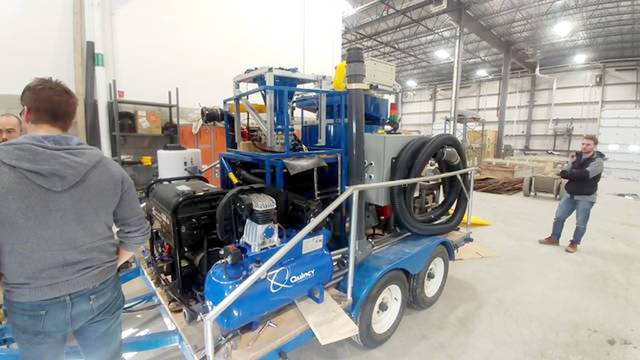HILO — The Hawaii Wildlife Fund is seeking donations to transport a prototype machine to the Big Island that can sort microplastics from beach sand.
A group of 12 engineering students from the University of Sherbrooke in Quebec, Canada, have worked in conjunction with the fund for two years to design a machine that can help remove small pieces of plastic marine debris from beaches.
A completed prototype of the machine, called the HoolaOne, will be tested on Hawaii beaches next month to determine its efficacy.
“The machine will be operated by the students initially, but the machine will belong to us,” said Bill Gilmartin, research director for the Hawaii Wildlife Fund.
Megan Lamson, program director for the fund, said extricating microplastics, or fragments 5 millimeters or less in diameter, from sand is a very slow process. Workers take a sample of beach sand into a mixing tray, add seawater, and wait as the less-dense plastic waste rises to the top of the water.
The machine operates by the same principle, but much more efficiently. The HoolaOne uses vacuums and pumps to gather sand and seawater more quickly and expel the clean sand back to the beach free of plastic contaminants.
Microplastics are an especially insidious form of plastic pollution due to their extremely small size. The tiny plastic fragments — which can be pieces of larger plastic debris or items like microbeads that are engineered to be extremely small — are consumed unwittingly by sea life, and can become trapped in their digestive systems, leading to health problems not only in the animals that eat the plastic, but in any animals that eat them as well.
Microplastics in the sand will either wash back out to sea or be consumed by beach-dwelling animals, but are impossible to be removed by hand.
Lamson said a given handful of sand from Big Island beaches likely is still mostly sand, but will include “a frightening amount of confetti color.”
The HoolaOne project was created as a baccalaureate project at Sherbrooke and was developed thanks to an investment of over $75,000 from several Canadian engineering firms.
Lamson said the Hawaii Wildlife Fund and HoolaOne are seeking $15,000 in donations to transport the machine, which is approx-
imately the size of a small trailer, and six of the Sherbrooke students over to the Big Island. The students will stay on the island for one to two weeks while they test the machine and make any necessary modifications or repairs.
The main testing ground for the HoolaOne will be Kamilo Point, located in Kau, which accumulates thousands of pounds of marine waste every year. Gilmartin said the location will be an ideal place to test the extent of the machine’s capabilities and gauge its adaptability in handling a wide variety of debris.
Regardless of the outcome of the tests, Lamson said the HoolaOne will remain with the Hawaii Wildlife Fund after the students return to Canada. Lamson said the Wildlife Fund intends to share the hopefully successful prototype with other Hawaiian environmental groups to help clean beaches across the state.


